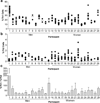T helper cell polarization in healthy people: implications for cardiovascular disease
- PMID: 23921946
- PMCID: PMC3806306
- DOI: 10.1007/s12265-013-9496-6
T helper cell polarization in healthy people: implications for cardiovascular disease
Abstract
Atherosclerosis is a chronic inflammatory disease characterized by T lymphocyte infiltration into the atherosclerotic plaque. Assessments of T cell subtypes have demonstrated a predominance of CD4(+) T helper (Th) cells, implicated Th1 and Th17 immunity in both human and mouse atherogenesis, and provided some evidence suggesting protective roles of Th2 and T regulatory cells. Observations that certain inbred mouse strains have an inherent T helper bias suggest a genetic predisposition toward developing a particular T helper phenotype. This review summarizes our current understanding of mechanisms of antigen processing for major histocompatibility complex molecules, describes the different T helper cell subsets and their roles in atherosclerosis, and discusses mechanisms of genetic predisposition toward Th1/Th2 bias in mice. We also present data from our laboratory demonstrating inherent Th1/Th2 phenotypes in apparently healthy human volunteers that are stable over time and discuss the potential implications for cardiovascular disease.
Figures




Similar articles
-
Different polarization and functionality of CD4+ T helper subsets in people with post-COVID condition.Front Immunol. 2024 Aug 27;15:1431411. doi: 10.3389/fimmu.2024.1431411. eCollection 2024. Front Immunol. 2024. PMID: 39257580 Free PMC article.
-
Immunologic Overlap of Helper T-Cell Subtypes 17 and 22 in Erythrodermic Psoriasis and Atopic Dermatitis.JAMA Dermatol. 2015 Jul;151(7):753-60. doi: 10.1001/jamadermatol.2015.2. JAMA Dermatol. 2015. PMID: 25760640
-
Th17 cell induction and immune regulatory effects.J Cell Physiol. 2007 May;211(2):273-8. doi: 10.1002/jcp.20973. J Cell Physiol. 2007. PMID: 17311299 Review.
-
Effects of anesthetic methods on preserving anti-tumor T-helper polarization following hepatectomy.World J Gastroenterol. 2012 Jun 28;18(24):3089-98. doi: 10.3748/wjg.v18.i24.3089. World J Gastroenterol. 2012. PMID: 22791944 Free PMC article. Clinical Trial.
-
The concept of type-1 and type-2 helper T cells and their cytokines in humans.Int Rev Immunol. 1998;16(3-4):427-55. doi: 10.3109/08830189809043004. Int Rev Immunol. 1998. PMID: 9505198 Review.
Cited by
-
Morphine and ketamine treatment suppress the differentiation of T helper cells of patients with colorectal cancer in vitro.Exp Ther Med. 2019 Jan;17(1):935-942. doi: 10.3892/etm.2018.7035. Epub 2018 Nov 29. Exp Ther Med. 2019. PMID: 30651883 Free PMC article.
-
HMGB1Modulates the Treg/Th17 Ratio in Atherosclerotic Patients.J Atheroscler Thromb. 2016 Jun 1;23(6):737-45. doi: 10.5551/jat.31088. Epub 2016 Feb 1. J Atheroscler Thromb. 2016. PMID: 26830200 Free PMC article.
-
Understanding Immune Responses to Viruses-Do Underlying Th1/Th2 Cell Biases Predict Outcome?Viruses. 2022 Jul 8;14(7):1493. doi: 10.3390/v14071493. Viruses. 2022. PMID: 35891472 Free PMC article. Review.
-
IL-33 modulates inflammatory brain injury but exacerbates systemic immunosuppression following ischemic stroke.JCI Insight. 2018 Sep 20;3(18):e121560. doi: 10.1172/jci.insight.121560. eCollection 2018 Sep 20. JCI Insight. 2018. PMID: 30232272 Free PMC article.
-
Longitudinal Variations in Th and Treg Cells Before and After Percutaneous Coronary Intervention, and Their Intercorrelations and Prognostic Value in Acute Syndrome Patients.Inflammation. 2025 Feb;48(1):316-330. doi: 10.1007/s10753-024-02062-x. Epub 2024 Jun 14. Inflammation. 2025. PMID: 38874809
References
-
- Fogg DK, Sibon C, Miled C, Jung S, Aucouturier P, Littman DR, Cumano A, Geissmann F. A clonogenic bone marrow progenitor specific for macrophages and dendritic cells. Science. 2006;311(5757):83–87. - PubMed
-
- Paulson KE, Zhu SN, Chen M, Nurmohamed S, Jongstra-Bilen J, Cybulsky MI. Resident intimal dendritic cells accumulate lipid and contribute to the initiation of atherosclerosis. Circ Res. 2010;106(2):383–390. - PubMed
Publication types
MeSH terms
Substances
Grants and funding
LinkOut - more resources
Full Text Sources
Other Literature Sources
Research Materials

